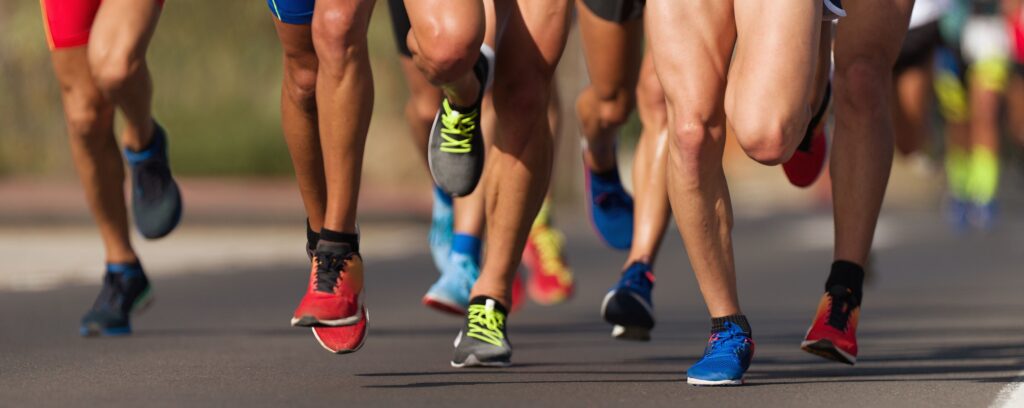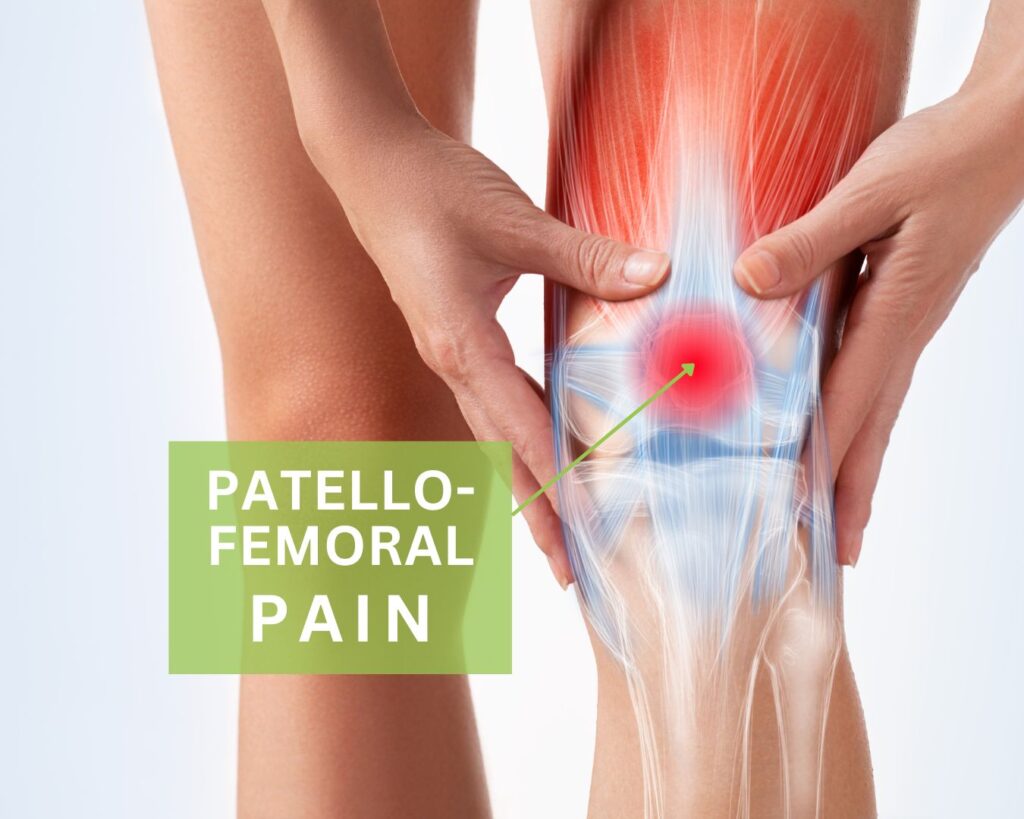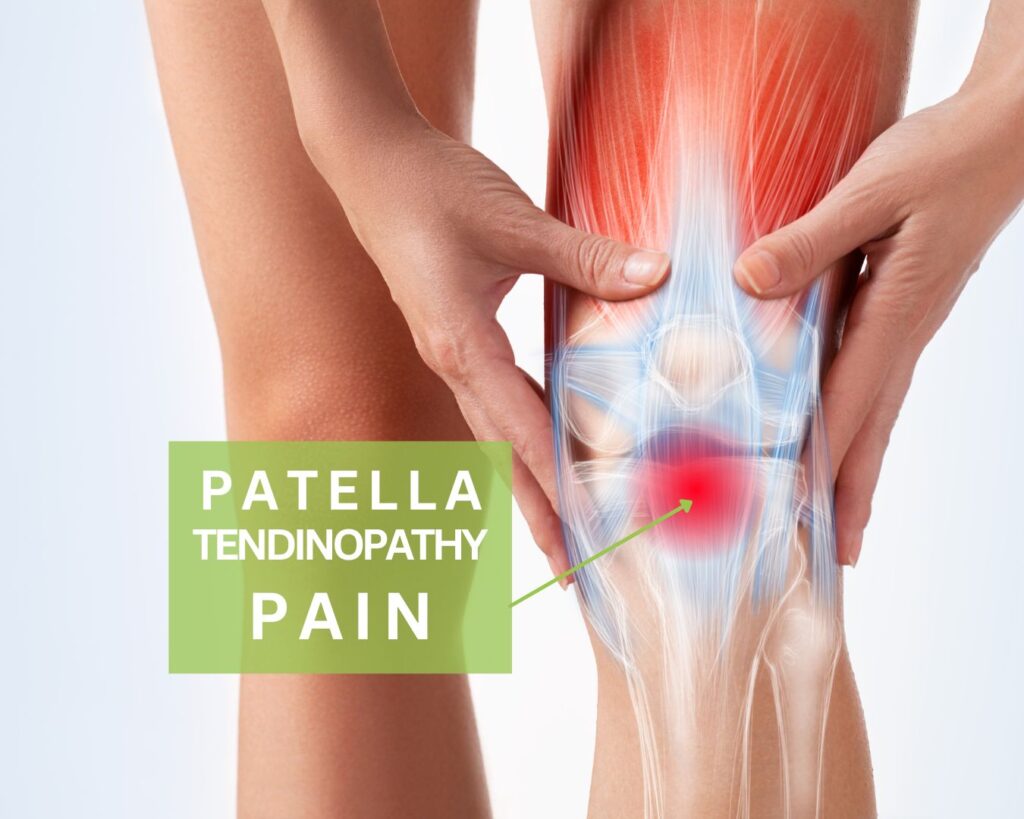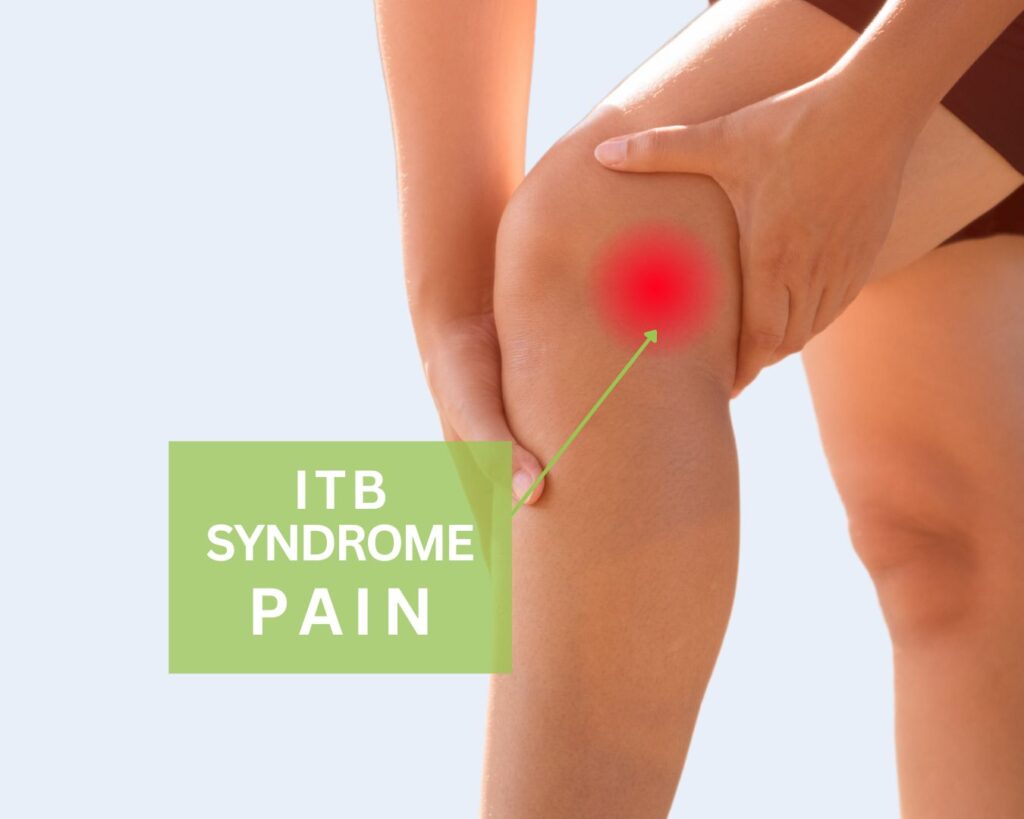
Running is a fantastic way to stay active and boost your fitness, but it’s not without its challenges. Many runners have experienced the frustrating and often debilitating discomfort of knee pain. Like many things related to our bodies, if good management is started early then many cases of running-related knee pain will resolve well and fairly quickly, but if left to get significantly worse then treatment is harder and takes longer. So, in this post we’ll try to help you self-diagnose what’s causing your pain so you can get onto it early, and begin some simple self-management strategies to keep you out on the road.
We will focus on the three most common types of knee pain experienced by runners: Patellofemoral Pain (Runner’s Knee), Patellar Tendinopathy, and ITB Syndrome. We’ll cover where the pain is felt, the common causes, how the pain usually behaves (what makes it worse/better), at-home tests you can use to help decide what’s wrong, and simple self-management strategies to try. So let’s get started!
Patellofemoral Pain (Runner’s Knee)

Where Is Patellofemoral Pain Felt?
Patellofemoral Pain is so common with runners it is commonly just known as “runner’s knee”. It is typically felt around the front of the knee, often beneath or around the kneecap (patella). Runners may describe a dull, aching pain that intensifies during activities like running, going downstairs, or sitting for extended periods.
What Are The Common Causes Of Patellofemoral Pain?
This type of pain can result from increasing your running training (volume or intensity) too quickly, imbalances in muscle strength, and some running gait issues can increase your risk. Weak hip muscles and some types of leg muscle tightness can contribute to changes in the biomechanics of your knee and patella, leading to patellofemoral pain. The role of footwear is unclear – it may be a significant contributor for some people, but not everyone.
What Makes Patellofemoral Pain Worse?
Patellofemoral pain tends to worsen during running, and can persist for a while after your run. Running downhill is often especially aggravating. In the early stages you may still be able to run for a reasonable time, especially if running on the flat, but as the condition progresses the pain comes on earlier (almost immediately in more severe cases), increases faster, and lasts for longer and longer after your run. If it gets to this relatively advanced stage it can stay sore and give you ongoing pain doing things like going up and down stairs, sitting for longer periods, squatting (e.g. to cupboards), and driving or getting in and out of the car. You may also start to feel some aches through the night or on getting up in the morning.
At-Home Tests For Patellofemoral Pan
1. Pain Location & Behaviour: Perhaps the most simple but effective self-test for patellofemoral pain is to think about where the pain is and how it behaves. As discussed above, if your pain feels like it is located around or behind your kneecap, and gets worse with going down stairs or running downhill, sustained sitting, or squatting, then you may have patellofemoral pain.
2. Step Down Test: Step off a small step or platform, like a bottom stair. If you feel pain around or behind your kneecap while doing this, it could indicate patellofemoral Pain.
Self-Treatment Strategies To Try Initially
1. Load Management: One of the most common causes of patellofemoral pain is increasing your activity (like running) too quickly, causing tissue overload and inflammation. So, logically, an initial management strategy is load management, i.e. reduce or stop your activity temporarily to let things settle down. In the early stages just reducing your running volume, frequency and intensity may be enough, but in more advanced cases a complete rest for a short time may be needed (although prolonged rest is not advised or effective). Once things have settled down you can gradually build up your running again, staying within acceptable limits for any symptoms along the way.
2. Strength Exercises For Your Knee And Hip: Research shows that strengthening your knee and hip muscles, in conjunction with load management, should form the foundation of effective treatment programs for patellofemoral pain. Depending on your level of pain and how easily it is stirred up, use a combination of double-leg exercises like squat variations, then progress through single-leg strength like lunges, Bulgarians, single-leg squats and step exercises. The best combination and progression of exercises will vary hugely for each person, but you should pay attention to how your knee feels during your strength exercises (mild niggles are generally ok, but sharper pains and those that make you change the way you move are not), and any knee pain should settle quickly after stopping the exercise.
Patellar Tendinopathy

Where Is Patella Tendinopathy Pain Felt?
The hallmark of patellar tendinopathy is localised pain just below the patella (kneecap), where the patellar tendon attaches to the tibia (shinbone). It is usually well localised, like you can put your fingers on it, which is a bit different to patellofemoral pain where often the pain feels “behind the kneecap somewhere”.
What Are The Common Causes Of Patella Tendinopathy?
This type of running-related knee pain is usually caused by overloading the patella tendon by sudden spikes in training volume and/or intensity, or changes in running surface e.g. excessive downhill running. The impact of running mechanics and footwear is still a little unclear, but these can also be relevant factors for some runners.
What Makes Patella Tendinopathy Pain Worse?
In the early stages of patella tendinopathy the pain is often present when you start running, then goes away as you warm up. Then, when you cool down after your run, the pain often comes back, and you may feel pretty achy the next morning until you warm up again. If the condition is allowed to get worse it starts taking longer to go away in your run, starts coming back again later in your run, is more painful for longer after your run, and can be really sore the next morning. In more severe cases the pain doesn’t go away when you run (it can get worse as you run), is really sore afterwards and the next morning, and you may start waking a bit through the night due to pain. Most people will have stopped running before they get to this point.
At-Home Tests For Patella Tendinopathy
1. Pain Location & Behaviour: As with patellofemoral pain above, you can learn a lot from where you feel your pain and how it behaves. If you feel your pain is definitely below your kneecap but above your shin, and behaves similar to the pattern described above, then there’s a good chance you have patella tendinopathy.
2. Palpation (Sore-To-Touch) Test: Press your fingertips into the tendon, from just beneath the patella and down to the bony top of the front of your shin bone, with a moderate amount of pressure. If you feel tenderness or pain it suggests that you likely have patellar tendinopathy.
3. Single-Leg Squat Test: Perform a controlled single-leg squat on your sore leg, slowly lowering yourself down as far as you can go. If this test reproduces pain in the area of the patella tendon, you may well have patellar tendinopathy. You can also do a similar test by doing a slow step-down off a step.
Self-Treatment Strategies To Try Initially
1. Load Management: Ok, you’re probably starting to notice a pattern here! Just like patellofemoral pain, patella tendinopathy is usually caused by overloading the tissues through ramping up your training too fast. So, reduce or stop your activity temporarily to let things settle down, then build your running back up more slowly. Once again, prolonged periods of rest are not helpful – you may feel better because you’re not running, but if you avoid load (running) for an extended time you become weaker and it’s then even harder to get back running.
2. Strength Exercises (Isometric, Eccentric, Kinetic Chain): Increasing the strength and resilience in your quadriceps muscle/tendon chain is a key part of treating patella tendinopathy. It increases the tissue capacity to take load, which increases it’s ability to cope with the demands of running, both now and into the future. The type of strength exercise required will vary a lot depending on factors such as your baseline strength, how irritated the tendon is, how long the pain has been there, and how your overall movement control is. Isometric strength is a good place to start if your tendon is significantly inflamed and painful, then eccentric loading is a great way to start progressing into more strength. As well as specific quads strength, you should then also include strengthening of your whole kinetic chain, i.e. your whole leg, hip and pelvis.
3. Foam Rolling Your Quad: Strength and loading are generally much bigger factors than tightness (length) in patella tendinopathy, but reducing muscle tension can still be helpful, especially for short-term relief. Try using a foam roller on your quads to do this, 3 minutes each side on alternate days is a good place to start. Please note that quads stretching is NOT recommended when you have patella tendinopathy, because it can actually aggravate the pain. So, if your quad feels tight and you want to relieve some tension, use a roller rather than stretch.
ITB Syndrome

Where Is ITB Syndrome Pain Felt?
ITB Syndrome pain is felt along the outer side of the knee, where the iliotibial band (ITB) compresses against a small bump of bone called the lateral femoral epicondyle, on the the outer surface of femur (thigh bone). There is also a small bursa there, which may be the tissue that actually causes the pain. The pain is usually fairly well localised however, if the condition has been left to get worse, the pain can spread out a bit more and be felt in a bigger area.
What Are the Common Causes Of ITB Syndrome
No surprises here! We often see ITB syndrome in runners who have increased their training volume or intensity too quickly. Also, strength, biomechanics and running gait have been shown to play a role in some cases. For example a cross-over running gait, where your foot lands in across the midline of your body (i.e. too much hip adduction), has been shown to be a risk factor for ITB syndrome. This gait/biomechanical problem may be due to weakness of your hip muscles, poor movement control (i.e. poor running gait), or both.
What Makes ITB Syndrome Pain Worse?
Pain from ITB Syndrome generally gets worse as you run more. Often it is felt more during the impact phase of running, especially when your foot strikes the ground. The sensation might be sharp or burn-like, and residual discomfort may linger after the run. If the pain has already been stirred up by running then you might also feel it with walking, stairs, and some lunging or squatting movements.
At-Home Tests For ITB Syndrome
1. Pain Location & Behaviour: Ok, I know this is getting REALLY repetitive, but the location and behaviour of your pain gives you huge clues about what is going on. If your pain is fairly well localised to the outside of your knee, gets worse as you run more (especially as you land on that side and move through stance phase), and gives you some catchy-type pain with walk/squat/lunge movements if it’s stirred up after a run, then there’s a good chance you have ITB syndrome.
2. Palpation (Sore-To-Touch) Test: Just like patella tendinopathy, there is usually pain if you press on the area. With your knee at about 30degrees bent (i.e. just a bit off fully straight), push into the bony area on the outside of your knee, where your pain is. You will usually feel fairly sharp tenderness there, especially if you keep the pressure on and then flex and extend you knee a little. At about 30degress of knee bend your ITB moves back and forth across this bony bump (called the lateral femoral epicondyle), so if you hold the pressure over this bony bump then bend/straighten your knee around the 30degree range you usually feel sharp pain as the ITB moves across forwards and backwards across it.
Self-Treatment Strategies To Try Initially
1. Load Management: Yep, you guessed right! Just like patellofemoral pain and patella tendinopathy, ITB syndrome is a tissue-overload problem, so the first thing to try is load management. Reduce or stop your running temporarily to let things settle down, then build your running back up more slowly. As usual, prolonged periods completely off running as generally not helpful, but a short time is sometimes necessary. Your pain should settle fairly quickly if you reduce your running enough, or if you fully stop running.
2. Strength Exercises: You should strengthen your major hip and leg muscles, especially your glutes muscles that abduct your leg, i.e. take your leg out to the side. These muscles are really important for stabilising your pelvis on your leg as you land on that foot and take your body-weight through that leg during the stance phase of running. Increasing the strength of these muscles is really helpful to increase the overall load-bearing capacity of tissues including the ITB. Interestingly, studies have shown that just increasing the strength of these muscles does not automatically correct the cross-over running gait that is associated with ITB syndrome. But, when combined with running gait coaching, you can generally correct this.
3. Increasing Your Mobility: While we view ITB syndrome as primarily a strength and tissue capacity issue, mobility (or more correctly tightness, a lack of mobility!) can play a role. Using a ball to release your TFL (the tensor fascia lata, the muscle on the outside of your hip that attaches to the ITB), and sometimes a roller or stretching to increase the flexibility of your other major leg muscles (quads, hamstrings, calf), can be helpful in some cases.
It is worth noting that foam rolling your ITB itself has been shown NOT to work! So, don’t waste your time rolling down your ITB – it’s just painful and doesn’t achieve anything significant. If tightness/mobility is an issue it’s got to do with the muscles that attach to and interact with your ITB, not the ITB itself.
Principles Of Managing These Three Types Of Running Knee Pain
This post was designed to give you some simple self-diagnosis tests for the 3 most common types of knee pain. We also wanted to give you some tips on things to try initially, to see if your pain will settle with just some simple self-management strategies. Obviously if your pain persists, or if it goes away for a while but then comes back, then you should get things checked out with your running physio. But following this simple advice will often really help with running-related knee pain, so its a great place to start.
From the above discussion you can see that there are some common factors for what causes knee pain in runners, and also where to start treating it. Many cases are caused by increasing your running volume and/or intensity too quickly, so load management is a critical first step. Strength training is a vital component in the effective long-term treatment for many cases of knee pain, because it increases your tissue’s loading capacity and can also help with your biomechanics and running gait.
If these early self-management strategies don’t fix the problem for you, then you need to speak to a running physio. In this post we have outlined the most common and simple principles, but the are lots of other things that need to be addressed if your pain is not resolving. These can include assessing your running gait, getting professional advice on which strength and mobility exercises you need to be doing, manual therapy (hands-on treatment) for some cases, footwear choice or orthotics, and also getting a properly structured running program.
Running Physio Advice And Help
If you need any help with running-related knee pain (or anything else running for that matter!), we’re happy to help. For an obligation-free chat with one of our running team feel free to call us on 9280 2322 or click below to email us a question. If you need to see us you can call us or book your session online.

